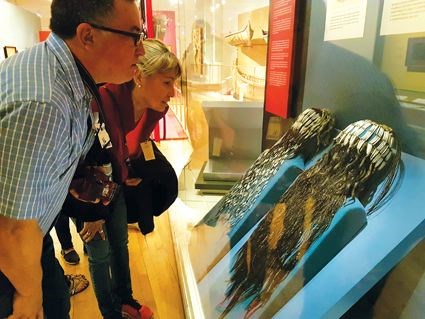The descendants of a central British Columbia First Nations chief recently had their first look at the ceremonial regalia he wore nearly 140 years ago.
Jim Munroe and his family from Prince George made the trip to Toronto in May to view the headdress.
The regalia, which is about 200 years old, was inherited from the chief's predecessors and eventually found a home in the Royal Ontario Museum, donated by Father Adrien Gabriel Morice, a missionary from northwestern B.C.
"I get goose bumps just thinking about it. I thought it was like visiting the Taj Mahal for our family," Munroe said.
"It's like royalty. And very rare that we were able to see this, for a family to have a direct lineage to an artifact such as this."
The headdress was donated to the Museum of Archeology in 1893-94 by Father Morice and the Royal Ontario Museum took over in 1912 where the artifact has been ever since.
Father Morice was acknowledged for his work as a missionary and for creating a writing system for the Dakelh (Carrier) language.
"This headdress, or 'wig' as Father Morice referred to it, is a remarkable artifact," said anthropologist John Dewhirst.
Dewhirst has done extensive research in the area of Carrier culture and history.
"It's incredible because this artifact is only one of two left in the world and both were collected by Father Morice. There are other pieces but none have survived," Dewhirst said.
The headdress is made of dentalia (flute shaped seashells) strung on the hair of deceased noble women.
For Munroe, from the Keyohwhudachun Maiyoo Keyoh Society, seeing the headdress for the first time with his wife Petra Sam, four of their children and his niece was overwhelming.
"This is important to us. It's a physical connection to our ancestors and a physical symbol of the jurisdiction, authority and responsibility they had, as Keyohwhudachun, to look after our Keyoh," Sam said.
"Each Keyohwhudachun passes that jurisdiction, authority and responsibility for the Keyoh down to the next. A long unbroken line of Maiyoo Keyoh Keyohwhudachun predates the arrival of Europeans in our area and this succession of Keyohwhudachun is in place to this day."
Dakelh law recognizes the heads of their extended families as Keyoh holders and the Keyohwudachun title is passed down from the family head from one generation to the next.
Keyoh holders and their families respect the authority and title to each other's territory and in 2008, protocol was established to formalize recognition and respect for one another.
According to Sam, Maiyoo Keyoh is about 17,000 hectares of land situated about 100 kilometres northwest of Prince George.
"It's one of the scores of Keyohs that divide the land from Prince George west to Fort St. James and beyond," Sam said.
They are the First Nations landholders in the area and existed long before the creation of Indian bands by provincial and federal governments.
"And we are preparing a statement of claim for the courts," Sam said.
Sam's mother, Sally, is the current Keyohwhudachun and is a fifth-generation lineal descendant of Chief Keyohwhudachun Sidoman, also known as George A'Huille, who is believed to be the last to own and entrust the headdress to Father Morice.
"He must have given this headdress to Father Morice," Munroe said.
"And we know this because of Father Morice's writings. He wrote about him."
Unable to make the long trip to Toronto, Sally Sam was thrilled to have her family make the visit to see the headdress for the first time.
And it was important for her 25-year-old granddaughter, Seraphine Munroe, to make the visit on her grandmother's behalf.
"Seeing the headdress in person represented a collective embrace of our family and legacy, not only legitimizing our authority but signaling a moment of collectiveness to our heritage," Seraphine said.
Her sister Anastazia, 20, said that the headdress is a significant cultural piece to symbolize resiliency of her connection to culture, ancestors and history that was thought to be lost forever.
And for Munroe, the trip has not ended.
"To see the headdress on display and in person, only 10 feet away from Sitting Bull's headdress, this was very humbling," he said.
"The headdress is an example of the wealth we once had as owners of our territories. My family is so proud. It's a part of us."



